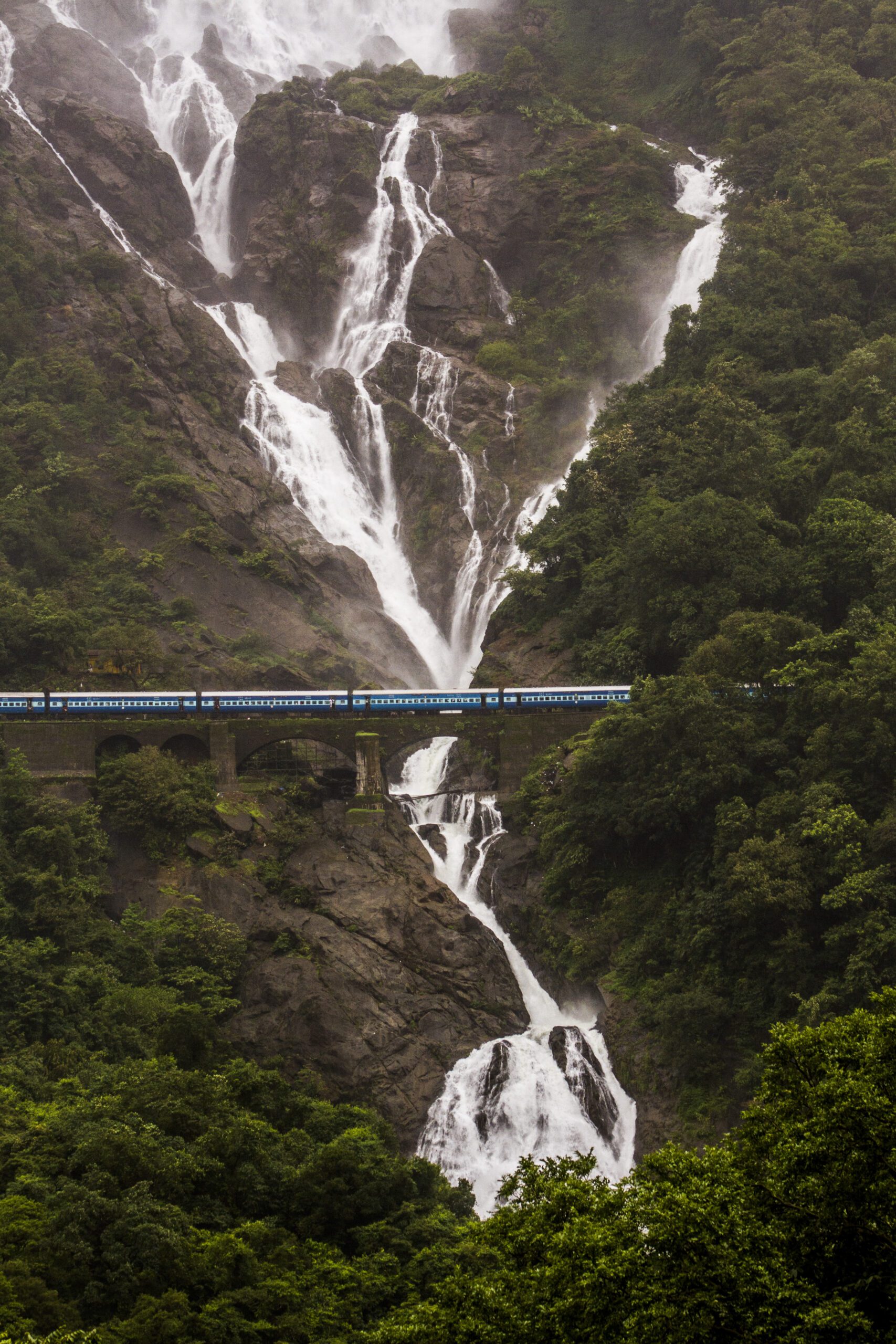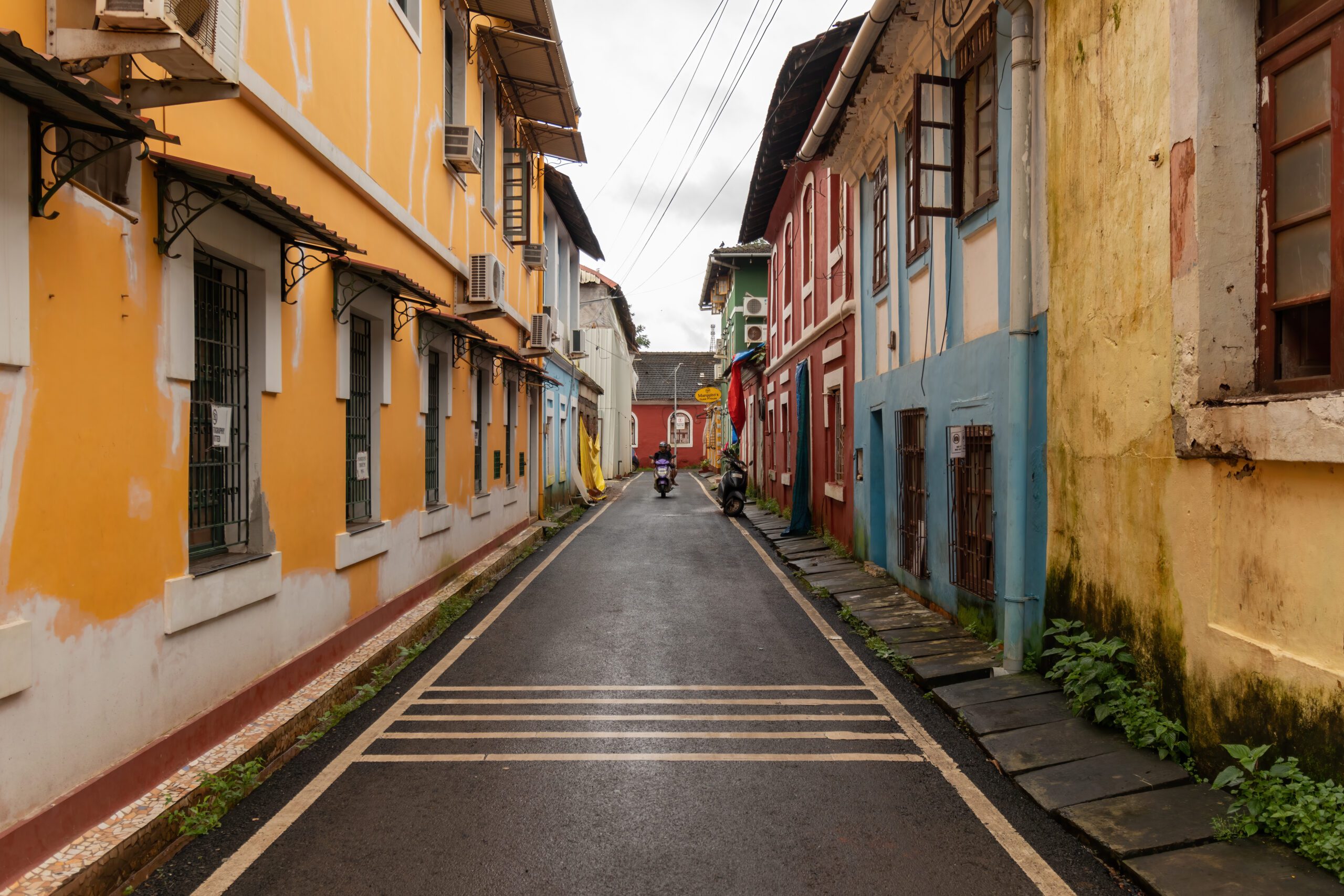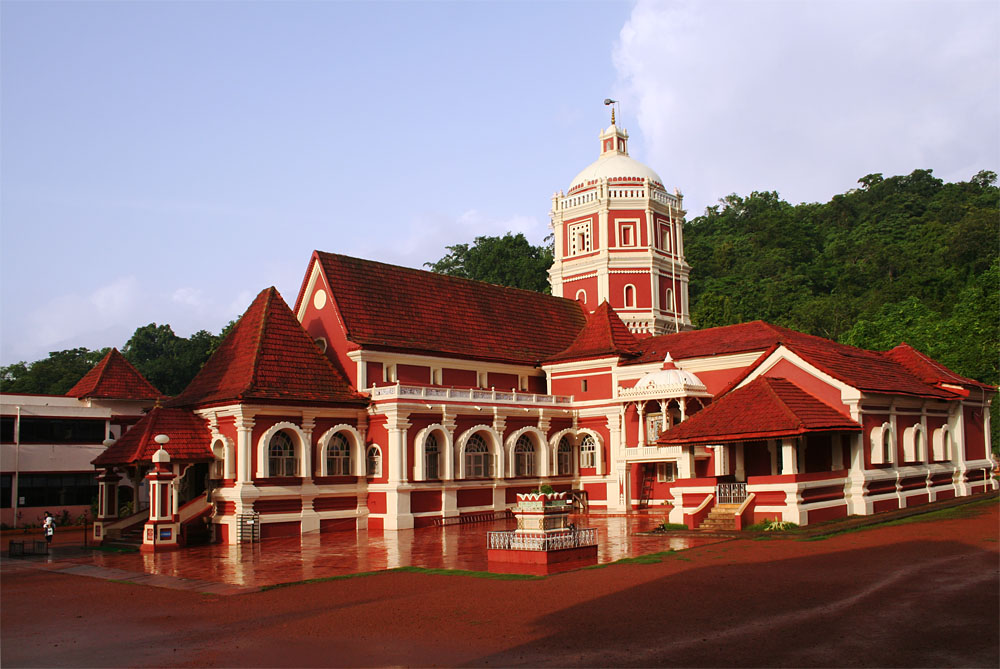
Dudhsagar Waterfall, meaning “Sea of Milk,” is one of India’s tallest and most breathtaking waterfalls, located on the Mandovi River in the Bhagwan Mahaveer Wildlife Sanctuary on the Goa–Karnataka border. Cascading from a height of approximately 310 meters (1,017 feet), this four-tiered natural wonder appears like a stream of milk gushing down the rocky slopes, especially during the monsoon season when the water flow is at its peak.
Surrounded by lush tropical forests and rich biodiversity, Dudhsagar is a popular destination for nature lovers, adventure seekers, and photographers. The site is accessible primarily by jeep safaris from the village of Kulem during the dry season (October to May), while monsoon treks and train views offer alternative experiences, though with more risk.
Whether you choose to admire the falls up close or view them dramatically from a passing train, Dudhsagar Waterfall remains a must-visit marvel of Goa’s natural landscape.
Significance of Dudhsagar Waterfall
- One of India’s Tallest Waterfalls: At approximately 310 meters (1,017 feet) high, Dudhsagar ranks among the tallest waterfalls in the country.
- Located in a Biodiversity Hotspot: The falls lie within the Bhagwan Mahaveer Wildlife Sanctuary, part of the Western Ghats, a UNESCO World Heritage Site known for its rich flora and fauna.
- Lifeline of the Mandovi River: Dudhsagar is formed by the Mandovi River, which is one of Goa’s primary rivers, playing a crucial role in its ecology and water supply.
- Spectacular Monsoon Transformation: During monsoons, the waterfall transforms into a powerful torrent, drawing thousands of visitors and inspiring awe with its force and beauty.
Images of Dudhsagar Waterfall, Goa
What to Explore at Dudhsagar Waterfall, Goa
A visit to Dudhsagar Waterfall isn’t just about viewing the falls—it’s an adventure packed with natural beauty, wildlife, and cultural charm. Here’s what you can explore in and around the area:
1. The Waterfall Viewpoint
- Main Attraction: Marvel at the majestic four-tiered cascade plunging into a rocky pool.
- Photography Spot: Iconic views from the railway bridge or the base viewpoint.
- Best Time: October to May (Jeep safaris operate; water levels are ideal).
2. Jeep Safari Ride
- Start Point: From Kulem or Collem village.
- Experience: 1-hour bumpy ride through streams, forest trails, and spice plantations.
- Includes: Entry to the Bhagwan Mahaveer Sanctuary and life jackets for swimming.
3. Bhagwan Mahaveer Wildlife Sanctuary
- Flora & Fauna: Spot langurs, wild boars, deer, exotic birds, butterflies, and rare plants.
- Nature Walks: Explore forest trails and enjoy the peaceful greenery of the Western Ghats.
4. Dudhsagar Railway Bridge
- Scenic Railway Crossing: Watch trains curve along the bridge with the waterfall in the backdrop.
- Trekking Views: Great views from afar, especially for photography lovers.
5. Devil’s Canyon (Nearby Spot)
- A deep gorge with striking rock formations and turbulent water flow.
- Best explored with a local guide; avoid swimming due to strong currents.
6. Tambdi Surla Mahadev Temple (Nearby)
- A 12th-century Kadamba-style temple dedicated to Lord Shiva.
- Surrounded by forest, it’s serene and spiritual—perfect for a peaceful detour.
7. Spice Plantations (En Route)
- Take a tour of local spice plantations near Ponda or Kulem.
- Learn about the cultivation of cardamom, black pepper, vanilla, and more.
8. Birdwatching & Nature Photography
- The area is a paradise for birdwatchers and nature photographers.
- Look for hornbills, kingfishers, Malabar giant squirrels, and butterflies.
How to Visit Dudhsagar Waterfall, Goa
Visiting Dudhsagar Waterfall requires a bit of planning, but the journey is as thrilling as the destination. Here’s a complete guide on how to reach and experience this majestic natural wonder:
1. By Jeep Safari (Best & Official Route)
Recommended from October to May
- Start Point: Kulem (Collem) village in South Goa
- Nearest city/town: Madgaon (35 km), Panaji (60 km)
- Transport: Drive/take a cab/train to Kulem railway station
- Jeep Booking: Book a forest-approved jeep from the Kulem Dudhsagar Jeep Association
What to expect:
- Jeep ride (~1 hour) through Bhagwan Mahaveer Sanctuary, river crossings, and jungle terrain
- Short walk (~10–15 mins) from drop-off point to the waterfall base
- Swimming allowed in the water pool (life jacket mandatory)
Approximate Costs:
- ₹400–₹700 per person (shared jeep)
- Entry fees + forest permit + life jacket charges included
2. By Trekking (Only for Experienced Trekkers)
- Risky & often restricted during monsoon
- From Kulem or Castle Rock (Karnataka)
- Trail distance: ~10–14 km through railway tracks or forest paths
- Railway track trekking is officially illegal and dangerous
- Trekking through forest trails is sometimes allowed with guides and permits
Best Time to Visit Dudhsagar Waterfall, Goa
The ideal time to visit Dudhsagar Falls depends on what kind of experience you’re seeking—lush greenery, water volume, accessibility, or photography. Here’s a seasonal breakdown:
1. Post-Monsoon (October to December) Best Time
- Water Flow: Strong and spectacular after heavy rains
- Weather: Pleasant and cool
- Accessibility: Jeep safaris are open and forest trails are safe
- Experience: Lush greenery, full waterfall, great for photography
2. Winter to Early Summer (January to May) Good
- Water Flow: Moderate but still beautiful
- Weather: Comfortable in Jan–Feb, hotter in Mar–May
- Crowds: Fewer tourists compared to post-monsoon
- Accessibility: Jeep safaris continue; trekking allowed with permission
3. Monsoon Season (June to September) Not Ideal / Risky
- Water Flow: Most powerful and dramatic
- Accessibility: Jeep safaris are closed
- Trekking: Railway and forest treks are dangerous and often banned
- Weather: Heavy rains, slippery terrain, risk of landslides
Tips for Visiting Dudhsagar Waterfall, Goa
Visiting Dudhsagar is a thrilling experience, but it requires some preparation due to its forest location and rugged access. Here are practical and safety tips to ensure a smooth and memorable trip:
Before You Go
1. Plan Your Visit in Season
- Best time: October to May (Jeep safari operates)
- Avoid monsoon: June to September (waterfall strong, but access is restricted)
2. Start Early
- Arrive at Kulem (Collem) by 8:00–9:00 AM to avoid crowds and ensure jeep availability.
3. Book in Advance (Optional but useful)
- During peak season or weekends, pre-book jeep safaris or guided tours through certified operators.
What to Carry
4. Essentials:
- Water bottle, snacks or energy bars
- Sunscreen, sunglasses, and cap
- Insect repellent (for forest areas)
- ID proof (required for entry)
5. Right Clothing:
- Wear comfortable trekking shoes or sandals with grip
- Quick-dry clothes or swimwear if planning to enter the water
- Carry a raincoat in post-monsoon or if rain is expected
6. Water Protection
- Use waterproof bags or zip locks for electronics and valuables
At the Waterfall
7. Use Life Jackets
- Mandatory if you plan to swim or enter the water pool
- Provided at the site with jeep packages
8. Don’t Litter
- Plastic is banned inside the sanctuary—respect the environment
9. Watch Your Step
- Rocks can be slippery—walk carefully, especially around water
10. No Drone Photography
- Drones are not allowed without special permission from forest authorities
Safety & Rules
11. Avoid Trekking on Railway Tracks
- It’s illegal and dangerous, especially during the monsoon
- Heavy fines and safety risks involved
12. Stay Within Designated Areas
- Avoid venturing too close to the edge or under the falls
13. Listen to Guides/Forest Staff
- Follow all instructions for your own safety and wildlife protection





